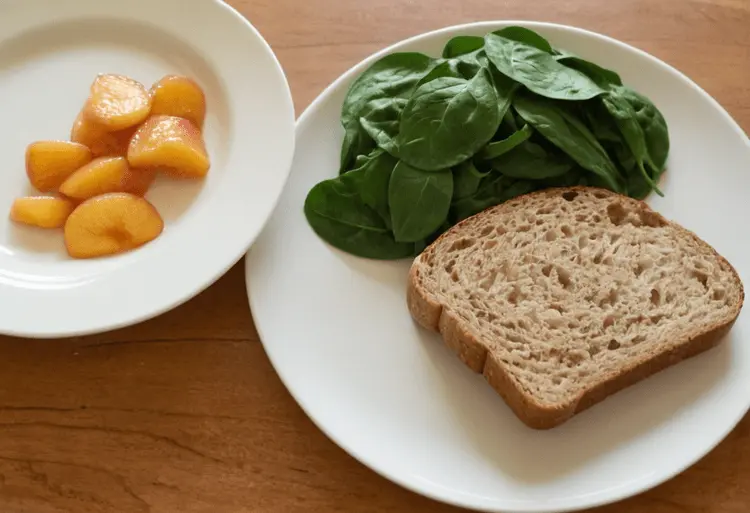If you struggle with persistent digestive issues like bloating, cramps, or unpredictable bowels, the low residue diet might be a solution worth exploring. This temporary eating plan can bring much-needed relief when other approaches fall short.
You might have tried various remedies, but nothing seems to provide lasting relief. The thought of restricting your diet with yet another “gut-friendly diet” may feel overwhelming.
The low residue diet might be the answer you’re looking for. This temporary eating plan focuses on foods easily digested, so reducing the work your intestines need to do.So it’s used for managing digestive health conditions or even preparing for a colonoscopy prep diet.
Unlike a typical low fiber diet, it offers more flexibility and can lead to significant improvement in your symptoms.
Low Residue Diet at a Glance
- Eat: Tender meats, cooked veggies, white grains
- Avoid: Whole grains, raw produce, tough foods
- Hydrate: Drink plenty of fluids
- Plan: Create sustainable meals/snacks
- Doctor: Consult for personalized guidanc
Table of contents
The Basics of the Low Residue Diet

Introduction
Ever feel like your digestive system needs a break? Struggling with uncomfortable symptoms that make you rethink your food choices? If so, this diet might be a temporary solution.
- What exactly is a low residue diet? It’s a way of eating designed to give your gut a rest. This diet reduces the amount of undigested food material, or “residue,” passing through your intestines.
- Why try it? this diet can ease symptoms like diarrhea, bloating, and abdominal pain.
What is Residue?
Think of residue as the leftover bits of food your body can’t break down completely. Fiber, a major component of many plant-based foods, is a big contributor to residue. Morover, While fiber is generally good for us, it can be bothersome when your digestion is struggling.
Who Benefits from a Low Residue Diet?
A low residue diet is often a short-term solution. Here’s when it might help:
- Flare-ups of digestive conditions: Like Crohn’s disease or ulcerative colitis
- Preparing for procedures: Think colonoscopies or certain bowel surgeries
- Recovering after surgery: To give your digestive system time to heal
- Managing acute diverticulitis: Inflammation of small pouches in your colon
How a Low Residue Diet Works
The magic of this diet is in reducing the workload on your gut. With less residue to process, you typically experience:
- Smaller, less frequent bowel movements
- Reduced strain and discomfort
- A chance for any inflammation or surgical areas to heal
Important Note: A low residue diet is almost always temporary. It’s important to consult with your doctor or a registered dietitian. So they can ensure it’s right for you and help you plan a balanced way to transition back to your regular diet.
Did you know that even after easing digestive troubles with the low residue diet, there’s more you can do? Probiotics offer a unique way to boost your gut’s long-term health. Ready to find out how?…
What to Eat and Avoid on a Low Residue Diet
Foods to Enjoy
Think soft, tender, and easy to digest. That’s the key to a successful low residue diet. So, what can you eat?
- Proteins: Choose lean options like chicken, fish, eggs, and even tofu. They provide the building blocks your body needs while being gentle on your system.
- Grains: Refined is your friend here! White bread, pasta, rice, and low-fiber cereals are all good choices. Think smooth, not crunchy.
- Fruits: Opt for canned or cooked fruits without skins or seeds. Ripe bananas, honeydew melon, and cantaloupe are tasty and well-tolerated options.
- Vegetables: Here’s where things get interesting. Well-cooked vegetables without skins or seeds are your best bet. Think carrots, green beans, and spinach. Can you enjoy raw veggies at all? Vegetable juices might be an option!
- Dairy (if tolerated): This can be tricky. Is your gut okay with some dairy? Limited amounts of milk, plain yogurt, and cheese may be possible depending on your individual tolerance.
- Other: Don’t forget about clear broths, plain gelatin, and some condiments for a little flavor boost!
Foods to Avoid
The goal with a low residue diet is to minimize the work your gut needs to do. Steer clear of these:
- Firstly, High Fiber Foods: Think of fiber as your digestive system’s workout routine. While great for health, it’s too intense right now. Skip whole grains, nuts, seeds, and most raw fruits & vegetables.
- Secondly,Tough or Fibrous Meats: Those chewy steaks and pork chops are a no-go for now.
- Thirdly, Spicy Foods: Is your system feeling a bit sensitive? Spice can irritate it further.
- Fourthly, Dried Fruits: Their concentrated fiber content is not your friend on this diet.
- Also, Gas-Producing Foods: Beans, lentils, and cruciferous vegetables like broccoli can lead to discomfort.
- Lastly, Potential Irritants: Think about what usually bothers your gut. Caffeine, alcohol, greasy, or fried foods might be on your personal “avoid” list.
Let’s Get Practical
Feeling a bit overwhelmed? Don’t worry! For additional guidance on navigating grocery aisles and restaurant menus, check out these resources:
- Diverticulitis and the low residue diet on the National Institute of Diabetes and Digestive and Kidney Diseases website.
Let me know how you’re doing with the low residue diet? Share your tips or challenges in the comments, or tag me on social media!
Creating a Low Residue Diet Plan
Making It Sustainable
Sticking to a low residue diet can feel restrictive, especially if you’re used to a wide variety of foods. But is it meant to be a forever thing? For most people, the answer is no!
So a low residue diet is usually a temporary solution to manage specific health conditions. Let’s focus on making this diet work for you in the short term, setting you up for a smoother transition back to more diverse eating later on.
Sample Meals and Snack Ideas
Need some inspiration to fuel your low residue diet journey? Here are a few ideas to get you started:
- Firstly, Breakfast:
- Scrambled eggs with a slice of refined white toast
- Low-fiber cereal with lactose-free milk (if tolerated)
- Ripe banana with a dollop of plain yogurt
- Secondly, Lunch:
- Tender chicken breast on a soft white bun
- Canned tuna salad with refined crackers
- Clear broth-based soup with cooked white rice
- Thirdly, Dinner:
- Baked fish with well-cooked carrots and mashed potatoes (no skin)
- Ground turkey meatloaf with a side of refined pasta
- Tofu stir-fry with soft vegetables and white rice
- Lastly, Snacks:
- Plain gelatin
- Applesauce (unsweetened)
- Hard-boiled egg
Hydration and Supplements

Staying hydrated on a low residue diet is super important! Aim to drink plenty of water, clear broths, and weak tea throughout the day.
Additionally, since the low residue diet limits many nutrient-rich foods, is a multivitamin a good idea? Discuss this with your doctor or a registered dietitian. They can help personalize a plan and choose the best supplements for your needs.
Working with a Healthcare Provider
Partnering with your doctor is crucial when following a low residue diet. Plus, want even more personalized support? Consider consulting a registered dietitian. They are experts in nutrition and can help you:
- Tailor the diet to your specific needs and preferences.
- Find suitable replacements for your favorite high-fiber foods.
- Develop strategies to ensure you’re getting enough nutrients.
How did that feel? Did I keep it easy to read? Let me know what you think in the comments, or tag me on social media!
Managing Life on the Low Residue Diet
Sticking to a low residue diet might feel overwhelming at first. But don’t worry! With some adjustments, you can navigate everyday situations without sacrificing your health or enjoyment of food.
Dealing with Potential Side Effects
The low residue diet, while helpful, can sometimes lead to constipation or feelings of nutrient deficiency. Is this a concern for you? Here’s what you can do:
- Stay hydrated: Water is your friend! It helps keep things moving and prevents constipation.
- Talk to your doctor: They might recommend gentle stool softeners or supplements to address any nutritional shortfalls.
Tips for Eating Out
Dining out doesn’t have to be off-limits on a low residue diet. A little planning can go a long way:
- Scout the menu beforehand: Many restaurants post their menus online. Look for simple dishes with familiar ingredients.
- Don’t be afraid to ask questions: Your server can provide details about preparation methods and suggest suitable options.
- Choose wisely: Grilled or broiled proteins, plain rice or potatoes, and steamed vegetables are often safe bets.
Traveling on a Low Residue Diet

Traveling with dietary restrictions can be stressful. Want to make it smoother? Consider these tips:
- Pack your own snacks: Don’t rely solely on airport or roadside food. Bring LRD-friendly snacks like rice cakes, nut butters (if tolerated), and fruit cups.
- Research your destination: Look for grocery stores or restaurants that cater to special diets. Check out resources like the International Foundation for Gastrointestinal Disorders (IFFGD): [invalid URL removed] for additional information on fiber content in foods.
- If you have a kitchen: Consider accommodations with kitchenettes so you can prepare some of your own meals.
Let’s Make This Work!
The low residue diet is a tool, not a life sentence. With a little creativity and planning, you can successfully manage it alongside your daily routines. Have you found any clever tips or tricks that make the low residue diet easier? Share them in the comments below or tag us on social media!
Loved the relief you got from the low residue diet? Now, amplify those benefits with delicious, gut-healthy recipes designed to nourish your digestive system long-term! Click here for ‘The Ultimate Guide to Gut Health Recipes‘
Your Low Residue Diet Questions Answered
Cooked vegetables (no skin/seeds), ripe/canned fruit, white bread/rice/pasta, tender meats, limited dairy.
Whole grains, most raw fruits/veggies, tough meats, nuts/seeds, beans, gas-causing foods.
It limits foods that leave “residue” (undigested material) in your gut.
Only liquids or foods that melt at body temperature (broth, gelatin, popsicles).
The low residue diet is usually a temporary solution. The length of time depends on your specific condition – it could be a few days or several weeks. Always check with your doctor for a personalized timeline.
While safe for short-term use, this diet isn’t meant for long-term management. It can lack certain vitamins, minerals, and especially fiber. Want to learn more about the importance of fiber? Check out this resource on the International Foundation for Gastrointestinal Disorders (IFFGD): invalid URL removed website.
Unfortunately, the choices are limited. Think soft, cooked vegetables without seeds and canned or ripe fruits without skin. Your healthcare provider will have a full list of what’s best
Potential risks include constipation and nutrient deficiencies.